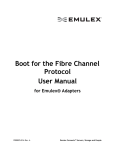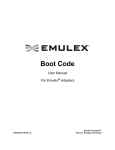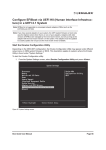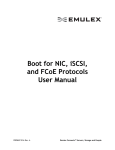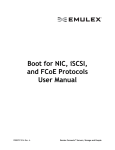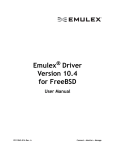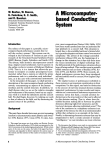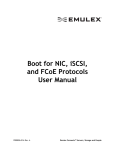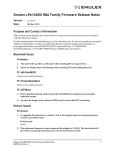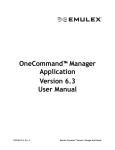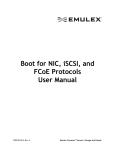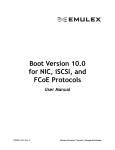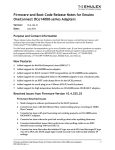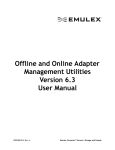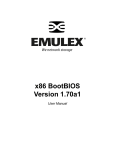Download (FC) boot code. This manual
Transcript
Boot Version 10.4 for the Fibre Channel Protocol User Manual P011056-01A Rev. A Connect • Monitor • Manage 2 Copyright © 2003-2015 Emulex. All rights reserved worldwide. No part of this document may be reproduced by any means or translated to any electronic medium without the prior written consent of Emulex. Information furnished by Emulex is believed to be accurate and reliable. However, no responsibility is assumed by Emulex for its use; or for any infringements of patents or other rights of third parties which may result from its use. No license is granted by implication or otherwise under any patent, copyright or related rights of Emulex. Emulex, the Emulex logo, Emulex BladeEngine, Emulex InSpeed, Emulex LightPulse, Emulex OneCommand, Emulex OneConnect, and SLI are registered trademarks, and Emulex Advanced-8, Emulex Connect, Emulex CrossLink, Emulex Engine, Emulex Edge, Emulex ExpressLane, Emulex GreenState, Network Xceleration, Emulex OneCore, Emulex Pilot, Emulex SURF, Emulex Universal Multi-Channel, Emulex vEngine, Emulex Virtual Fabric, Emulex Virtual Network Exceleration, Emulex vPath, Emulex vScale, AutoPilot, AutoPilot Installer, and BlockGuard are trademarks, of Emulex. All other brands or product names referenced herein are trademarks or registered trademarks of their respective companies or organizations. Emulex provides this manual "as is" without any warranty of any kind, either expressed or implied, including but not limited to the implied warranties of merchantability or fitness for a particular purpose. Emulex may make improvements and changes to the product described in this manual at any time and without any notice. Emulex assumes no responsibility for its use, nor for any infringements of patents or other rights of third parties that may result. Periodic changes are made to information contained herein; although these changes will be incorporated into new editions of this manual, Emulex disclaims any undertaking to give notice of such changes. Emulex, 3333 Susan Street Costa Mesa, CA 92626 Boot for the Fibre Channel Protocol User Manual P011056-01A Rev. A Table of Contents Table of Contents List of Figures ......................................................................................6 List of Tables .......................................................................................8 1. Introduction .....................................................................................9 Emulex Boot Code Files .............................................................................. 9 Abbreviations .......................................................................................... 9 2. Booting from SAN............................................................................. 13 Windows Server ..................................................................................... 14 Configuring Boot from SAN on Windows Server (x64) ......................................14 Installing a New Windows UEFI–aware Operating System on a UEFI-based x64 Server .................................................................................................. 14 Directing a UEFI-based Server to a Windows Server Operating System Image (Installed as UEFI-Aware) Already Installed on the SAN ....................................... 15 The GUID Partition Table ........................................................................... 15 Installing Windows Server on an FC Boot Disk ...............................................16 Linux,Citrix, and VMware ......................................................................... 16 Configuring Boot from SAN on Linux or VMware (x86 and x64) ...........................17 Configuring Boot from SAN on Linux or VMware (UEFI) ....................................17 Solaris ................................................................................................. 17 Configuring Boot from SAN on Solaris (x86 and x64) .......................................17 Determining LUNs to Select for Boot from SAN ................................................. 18 Configuring Boot from SAN on Solaris (SPARC) ..............................................18 Installing Solaris from a Network Image......................................................19 Installing Solaris by Migrating an Image from a Local SCSI Disk .............................. 21 3. Updating and Enabling Boot Code......................................................... 24 4. Emulex BIOS Utility .......................................................................... 25 Navigating the FCoE BIOS Utility ................................................................. 25 Starting the Emulex BIOS Utility ................................................................. 25 Enabling an Adapter to Boot from SAN .......................................................27 Configuring Boot Devices .......................................................................... 27 Configuring Adapter Parameters ................................................................. 31 Changing the Default AL_PA (Arbitrated Loop Physical Address).........................32 Changing the PLOGI Retry Timer ..............................................................33 Changing Topology...............................................................................34 Enabling or Disabling the Spinup Delay.......................................................36 Boot for the Fibre Channel Protocol User Manual P011056-01A Rev. A 3 Table of Contents Setting Auto Scan ................................................................................37 Enabling or Disabling EDD 3.0..................................................................38 Enabling or Disabling the Start Unit Command..............................................38 Enabling or Disabling the Environment Variable ............................................39 Enabling or Disabling Auto Boot Sector.......................................................40 Changing Link Speed ............................................................................41 Resetting to Default Values ....................................................................42 Using Multi-Path Boot from SAN ...............................................................44 5. OpenBoot ...................................................................................... 45 Attribute Commands................................................................................ 45 .boot-id............................................................................................45 devalias............................................................................................45 .fcode..............................................................................................45 host-did............................................................................................45 .nvram .............................................................................................46 probe-scsi-all .....................................................................................46 show-devs .........................................................................................46 .topology ..........................................................................................46 Functional Commands .............................................................................. 47 .remove-boot-id..................................................................................47 set-default-mode ................................................................................47 set-link-speed ....................................................................................47 set-max-lun .......................................................................................48 set-post-linkup ...................................................................................48 OpenBoot Signature .............................................................................48 6. Configuring Boot via UEFI HII (Human Interface Infrastructure) in a UEFI 2.1 System.................................................................................. 50 Updating an Adapter’s Firmware or Boot Code ............................................... 50 Starting the Emulex Configuration Utility ...................................................... 50 Emulex Configuration Utility Conventions in UEFI/HII .....................................51 Configuring Boot in UEFI/HII ...................................................................... 52 Setting Boot from SAN.............................................................................. 52 Scanning for Fibre Devices ........................................................................ 53 Adding Boot Devices ................................................................................ 54 Deleting Boot Devices .............................................................................. 55 Changing Boot Device Order ...................................................................... 56 Configuring Adapter Parameters ................................................................. 58 Boot for the Fibre Channel Protocol User Manual P011056-01A Rev. A 4 Table of Contents Changing the Topology..........................................................................60 Changing the PLOGI Retry Timer ..............................................................61 Changing the Link Speed........................................................................62 Configuring Boot Parameters ..................................................................... 63 Changing the Maximum LUNs per Target.....................................................63 Changing Boot Target Scan Method ...........................................................64 Changing Device Discovery Delay..............................................................66 Resetting Emulex Adapters to Default Values ................................................. 67 Displaying Adapter Information .................................................................. 68 Legacy Only Configuration Settings.............................................................. 69 Returning to the UEFI Device Manager ......................................................... 70 7. Troubleshooting .............................................................................. 71 x86 BootBIOS ......................................................................................... 71 OpenBoot ............................................................................................. 71 Boot for the Fibre Channel Protocol User Manual P011056-01A Rev. A 5 List of Figures List of Figures Figure 4-1 Figure 4-2 Figure 4-3 Figure 4-4 Figure 4-5 Figure 4-6 Figure 4-7 Figure 4-8 Figure 4-9 Figure 4-10 Figure 4-11 Figure 4-12 Figure 4-13 Figure 4-14 Figure 4-15 Figure 4-16 Figure 4-17 Figure 4-18 Figure 4-19 Figure 4-20 Figure 6-1 Figure 6-2 Figure 6-3 Figure 6-4 Figure 6-5 Figure 6-6 Figure 6-7 Figure 6-8 Figure 6-9 Figure 6-10 Figure 6-11 Figure 6-12 Figure 6-13 Figure 6-14 Figure 6-15 Figure 6-16 Figure 6-17 Figure 6-18 Figure 6-19 Adapter Listing Screen ...................................................................26 Main Configuration Menu.................................................................26 BIOS Status Screen ........................................................................27 List of Saved Boot Devices Screen ......................................................28 Device Selection List Example (Array) Screen ........................................29 LUN listing Screen.........................................................................29 Boot Devices Menu ........................................................................30 Primary Boot Device Set Up Screen ....................................................30 Adapter Configuration Menu.............................................................31 Change Default ALPA Screen ............................................................32 Change the PLOGI Retry Timer Screen.................................................34 Topology Menu.............................................................................35 Enable or Disable Spinup Delay Screen ................................................36 Set Auto Scan Menu .......................................................................37 Enable or Disable EDD 3.0 Screen ......................................................38 Enable or Disable Start Unit Command Screen .......................................39 Enable or Disable Environment Variable Screen......................................40 Enable or Disable Auto Sector Format Select Screen................................41 Link Speed Selection Menu ..............................................................42 BIOS Utility Screen ........................................................................43 Storage Screen.............................................................................50 Emulex Adapter Configuration Main Menu ............................................51 Main Menu, Boot from SAN Options Menu .............................................52 New Boot From SAN Setting .............................................................53 Discovered Targets Screen...............................................................53 Discovered Targets Screen...............................................................54 Boot Device Screen .......................................................................54 Commit/Discard Changes Menu .........................................................55 Boot Device Screen .......................................................................55 Selected Boot Device is highlighted ....................................................56 Confirm Boot Device Delete .............................................................56 Discovered Targets Screen...............................................................57 Boot Device Order Screen................................................................57 Boot Device Order Menu .................................................................58 Adapter Configuration Menu.............................................................59 Topology Menu.............................................................................60 PLOGI Retry Timer Menu Screen ........................................................61 Force Link Speed Menu Screen ..........................................................63 Maximum LUNs/Target Screen ..........................................................64 Boot for the Fibre Channel Protocol User Manual P011056-01A Rev. A 6 List of Figures Figure Figure Figure Figure Figure Figure 6-20 6-21 6-22 6-23 6-24 6-25 Boot Target Scan Method Menu Screen ................................................65 Delay Device Discovery Screen..........................................................66 Adapter Defaults Menu ...................................................................68 Adapter Selection Screen ................................................................68 Adapter Information Screen...........................................................69 Legacy Only Configuration Settings screen............................................70 Boot for the Fibre Channel Protocol User Manual P011056-01A Rev. A 7 List of Tables List of Tables Table Table Table Table Table Table Table Table 2-1 3-1 4-1 4-2 5-1 6-1 7-1 7-2 Boot from SAN Procedures ...............................................................13 Utilities that Update and Enable Boot Code ..........................................24 Valid AL_PA Values........................................................................32 Adapter Defaults ..........................................................................42 OpenBoot Signature Table ...............................................................48 Adapter Defaults ..........................................................................67 x86 BootBIOS Troubleshooting ..........................................................71 OpenBoot Troubleshooting ..............................................................71 Boot for the Fibre Channel Protocol User Manual P011056-01A Rev. A 8 1. Introduction Emulex Boot Code Files 1. Introduction This manual describes installing, updating, enabling, and configuring Emulex® Fibre Channel (FC) boot code. This manual also describes the Emulex boot from SAN implementation and its operation with distinct hardware and operating system requirements. Boot from SAN is booting servers directly from disk operating system images located on a storage area network (SAN) by way of Emulex LightPulse® adapters using Emulex FC boot code. When booting from SAN, the storage device is typically identified by its World Wide Port Name (WWPN) and a logical unit number (LUN). By extending the server system boot basic input/output system (BIOS), boot from SAN functionality is provided by the bootBIOS contained on an Emulex adapter in the server. When properly configured, the adapter then permanently directs the server to boot from a logical unit (disk) on the SAN as if it were a local disk. Notes Emulex drivers support multi-path boot configurations. Refer to your storage vendor’s documentation for details on how to configure multi-path booting. Screenshots in this manual are for illustrative purposes only. Your system information can vary. Emulex Boot Code Files Emulex is unique in providing Universal Boot and Pair Boot images of boot code. Universal Boot images contain x86 BootBIOS, OpenBoot, and EFIBoot boot code. Pair Boot boot code images contain x86 BootBIOS and EFIBoot boot code. These images provide multi-platform support for boot from SAN. Universal Boot and Pair Boot transparently determine your system platform type and automatically execute the proper boot code image in the adapter. These boot code images reside in the adapter’s flash memory, allowing for easier adapter portability and configuration between servers. Emulex provides the following types of boot code: x86 BootBIOS works with the existing system BIOS on x64 and x86 systems. OpenBoot works with the existing system firmware on SPARC systems. OpenBoot is also called FCode. UEFIBoot provides system boot capability through the use of the UEFI (Unified Extensible Firmware Interface) shell. It also functions on UEFI 2.x-based x64 platforms through the HII (Human Interface Infrastructure) interface. Abbreviations ACL Access Control List AL_PA Arbitrated Loop Physical Address Boot for the Fibre Channel Protocol User Manual P011056-01A Rev. A 9 1. Introduction Abbreviations API application programming interface ARP Address Resolution Protocol BBS BIOS Boot Specification BFS byte file system BIOS basic input/output system CLI command line interface DHCP Dynamic Host Configuration Protocol DID device ID DMA direct memory access DNS Domain Name System EDD Enhanced Disk Device FC Fibre Channel FC-AL Fibre Channel Arbitrated Loop FCF FC Forwarder FL_Port fabric loop port FoD Feature on Demand FTP File Transfer Protocol FUI FoD Unique Identifier Gbps gigabits per second GPT GUID partition table GUI graphic user interface GUID Globally Unique Identifier HBA host bus adapter HII Human Interface Infrastructure HTTP Hypertext Transfer Protocol IEEE Institute of Electrical and Electronics Engineers INTx PCIe legacy interrupts, where “x” is variable I/O input/output IOCTL input/output control IP internet protocol JBOD just a bunch of disks KB 1024 bytes (Kilobyte or Kibibyte) LACP Link Aggregation Control Protocol LDAP Lightweight Directory Access Protocol LUN logical unit number MAC media access control MBR master boot record Boot for the Fibre Channel Protocol User Manual P011056-01A Rev. A 10 1. Introduction Abbreviations MPIO multipath I/O MSI message signaled interrupts MSI-X message signaled interrupts - extended MTU maximum transmission unit NBP network bootstrap program NIS/NIS+ Network Information Service/Network Information Service Plus NIV Network Interface Virtualization NLB network loopback NPIV N_Port ID virtualization NVRAM non-volatile random-access memory OBP OpenBoot PROM OEM original equipment manufacturer OS operating system PC personal computer PCI Peripheral Component Interconnect PCIe Peripheral Component Interconnect Express PDU protocol data unit PLOGI port login POST power on self test PXE Preboot eXecution Environment RAID redundant array of independent disks RHEL Red Hat Enterprise Linux RIS Remote Installation Services ROM read-only memory RPM resource package manager RSS receive side scaling SAN storage area network SCSI Small Computer System Interface SLES SUSE Linux Enterprise Server SLI Service Level Interface SMS System Management Services SNP Simple Network Protocol X Denotes a variable TB terabyte TCP transmission control protocol TFTP Trivial File Transfer Protocol UCNA universal converged network adapter Boot for the Fibre Channel Protocol User Manual P011056-01A Rev. A 11 1. Introduction Abbreviations UDP User Datagram Protocol UFP Unified Fabric Protocol UEFI Unified Extensible Firmware Interface USB Universal Serial Bus WWN World Wide Name WWNN World Wide Node Name WWPN World Wide Port Name ZB zettabytes Boot for the Fibre Channel Protocol User Manual P011056-01A Rev. A 12 2. Booting from SAN Abbreviations 2. Booting from SAN This section provides instructions for installing and using all of the types of boot code provided by Emulex. When booting from SAN, the storage device is typically identified by its WWPN and a LUN. By extending the server system BIOS, boot from SAN capability is provided by the boot BIOS contained on an Emulex adapter in the server. If properly configured, the adapter then permanently directs the server to boot from a logical unit (disk) on the SAN as if it were a local disk. Note: Not all procedures are required. Emulex HBAs usually ship from the factory with the latest version of boot code installed and enabled, so you do not need to install or enable boot code in those cases. However, if boot code is not installed, you must install it, and if it is not enabled, you must enable it. Check the Emulex website at http://www.emulex.com for the latest version of boot code. This section describes setting up a system to boot from SAN. The specific procedure to follow is determined by the system architecture and the operating system. Table 2-1 Boot from SAN Procedures Architecture Operating System Procedure x86 and x64 Windows Server “Installing Windows Server on an FC Boot Disk” on page 16. Linux “Configuring Boot from SAN on Linux or VMware (x86 and x64)” on page 17. VMware SPARC and PowerPC Solaris (SFS driver) “Configuring Boot from SAN on Solaris (SPARC)” on page 18. Linux “Configuring Boot from SAN on Linux or VMware (UEFI)” on page 17. Solaris (SFS driver) “Configuring Boot from SAN on Solaris (x86 and x64)” on page 17. Boot for the Fibre Channel Protocol User Manual P011056-01A Rev. A 13 2. Booting from SAN Windows Server Windows Server This section describes configuring boot from SAN for Windows systems and installing Windows Server on an FC boot disk. Configuring Boot from SAN on Windows Server (x64) To configure boot from SAN: 1. If necessary, update the boot code on the adapter (see “Updating and Enabling Boot Code” on page 24). 2. If necessary, enable the boot code on the adapter (see “Updating and Enabling Boot Code” on page 24). 3. Enable the adapter to boot from SAN (see “Enabling an Adapter to Boot from SAN” on page 27). 4. By default, the boot adapter uses auto topology with loop first. You can set the boot adapter to use a different topology (see “Changing Topology” on page 34). 5. Configure boot devices (see “Configuring Boot Devices” on page 27). 6. If desired, configure the boot options on the adapter (see “Configuring Adapter Parameters” on page 31). 7. Install the operating system on an FC boot disk (see “Installing Windows Server on an FC Boot Disk” on page 16). Installing a New Windows UEFI–aware Operating System on a UEFI-based x64 Server This installation procedure assumes LUNs are created in the SAN storage device and zoned appropriately to the host adapter's WWN. 1. From the server system UEFI setup, ensure that CD/DVD is the first device in the boot order list. 2. Enable the adapter BIOS setting to allow SAN boot in the Emulex UEFI configuration utility. 3. Configure the boot target and LUN in the Emulex UEFI configuration utility to point to the desired target (see “Configuring Boot Parameters” on page 63). 4. Boot the host server with the Windows Server operating system DVD inserted. Follow the on-screen prompts to install the appropriate version of Windows Server. The Windows installation exposes all available and visible LUNs as disks and partitions numbered 0 to N, where N is the highest number available. These numbers typically are the LUN numbers assigned by the array. 5. Select the disk on which you want to install the operating system. 6. Follow the system prompts in the Windows installation. Note: The operating system image is installed with the GPT disk partition. See “The GUID Partition Table” on page 15 for a brief description of GPT disk partitions. Boot for the Fibre Channel Protocol User Manual P011056-01A Rev. A 14 2. Booting from SAN Windows Server After the installation is complete, a Boot Option variable called Windows Boot Manager is populated with a Media Device path pointing to the Windows boot loader utility. The Windows Boot Manager can be found in the Start Options menu of the host server UEFI. The Windows Boot Manager option is inserted as the first boot option in the boot order list of the Host Server UEFI. The CD/DVD boot is the second device in the boot order list. Upon reboot, the system boots from the LUN set up on the SAN. Directing a UEFI-based Server to a Windows Server Operating System Image (Installed as UEFI-Aware) Already Installed on the SAN This installation procedure assumes a LUN exists in the SAN storage device, is zoned appropriately to the host adapter’s WWN, and a UEFI-aware operating system resides on the target LUN. To direct a UEFI-based server to a Windows Server operating system image: 1. Enable boot from SAN in the Emulex UEFI configuration utility. 2. Configure the boot target and LUN in the Emulex UEFI configuration utility to point to the desired target (see “Configuring Boot Parameters” on page 63). 3. Select Boot Manager from the System UEFI configuration manager. 4. Select Add Boot Option. 5. Identify the desired target in the list, and continue down the explorer path until you locate the bootmgfw.efi file. This file is the boot loader utility for your Windows Server UEFI-aware operating system installation. 6. Input a boot device description (such as Win2K8_UEFI_SAN) and optional data (if desired) for this device and select Commit Changes. 7. From the Boot Manager, select Change Boot Order. 8. Move the previous input description name (Win2K8_UEFI_SAN) to the desired position in the boot order. 9. Select Commit Changes. The Start Options list now reflects the boot order changes. Upon reboot, the server is able to boot from this target LUN on the SAN. The GUID Partition Table The GPT provides a more flexible mechanism for partitioning disks than the older MBR partitioning scheme that has been common to PCs. MBR supports four primary partitions per hard drive and a maximum partition size of 2 TB. If the disk is larger than two TB (the maximum partition size in a legacy MBR), the size of this partition is marked as 2 TB and the rest of the disk is ignored. The GPT disk itself can support a volume up to 264 blocks in length (for 512-byte blocks, this is 9.44 ZB). The GPT disk can also theoretically support unlimited partitions. Boot for the Fibre Channel Protocol User Manual P011056-01A Rev. A 15 2. Booting from SAN Linux,Citrix, and VMware Note: By default, Microsoft Windows Server operating systems install with a GPT-formatted disk on a UEFI-aware server. For more information on the GUID partition table, see the Microsoft website and search for the terms Windows and GPT FAQ. Installing Windows Server on an FC Boot Disk This procedure installs Windows Server onto an unformatted FC disk drive and configures the system to boot from the SAN disk drive. Note: The computer’s system BIOS may require that another controller take precedence over the Emulex adapter during boot. If this occurs, you must disconnect or disable the other adapter. This allows you to configure and build the operating system on the drive connected to the Emulex adapter. To install Windows Server on a boot disk: 1. Install the Emulex driver for Windows as described in the Emulex Drivers Version for Windows User Manual. 2. In Windows Explorer, navigate to the folder you specified during driver installation. 3. In the \AutoPilot Installer\Drivers\drivername folder, open the folder that corresponds to your computer type, such as x64. “drivername” is the type of driver you downloaded. 4. Copy all the files in this folder onto a formatted floppy disk or a USB device. 5. Boot the target system with the Windows Server setup media. The Install Windows splash screen is displayed. 6. Verify and if necessary change the Language, Time and Date, and Keyboard values. Click Next. Another splash screen is displayed. 7. Click Install Now. The Where do you want to install Windows? screen is displayed. 8. Click Load Driver. Browse to the floppy disk or USB device specified in step 4 where the driver is located to load the Storport Miniport driver for the appropriate operating system. Once selected, the correct driver location and driver are displayed under the Select driver to be installed screen. 9. Select Next. After the driver is loaded, the Where do you want to install Windows? screen is displayed. 10. Select the same drive you configured as the boot device (see “Configuring Boot Devices” on page 27). Linux,Citrix, and VMware This section describes configuring boot from SAN on Linux, Citrix, and VMware operating systems. Boot for the Fibre Channel Protocol User Manual P011056-01A Rev. A 16 2. Booting from SAN Solaris Configuring Boot from SAN on Linux or VMware (x86 and x64) To configure boot from SAN: 1. If necessary, install or update the boot code on the adapter (see “Updating and Enabling Boot Code” on page 24). 2. If necessary, enable the boot code on the adapter (see “Updating and Enabling Boot Code” on page 24). 3. Enable the adapter to boot from SAN (see “Enabling an Adapter to Boot from SAN” on page 27). 4. By default, the boot adapter uses auto topology with loop first. If you want to set the boot adapter to use a different topology, change it (see “Changing Topology” on page 34). 5. Configure boot devices (see “Configuring Boot Devices” on page 27). 6. If desired, configure the boot options on the adapter (see “Configuring Adapter Parameters” on page 31). 7. Use the driver on the operating system distribution disk to boot the system. If necessary, you can then update the driver to the desired version. Configuring Boot from SAN on Linux or VMware (UEFI) To configure boot from SAN: 1. If necessary, update the latest boot code on the adapter (see “Updating and Enabling Boot Code” on page 24). 2. If necessary, enable the boot code on the adapter (see “Updating and Enabling Boot Code” on page 24) 3. Configure boot devices. See “Enabling an Adapter to Boot from SAN” on page 27 for more information. 4. If desired, configure the boot options on the adapter. See “Configuring Adapter Parameters” on page 31 for more information. 5. Use the driver on the operating system distribution disk to boot the system. If necessary, you can update the driver to the latest version. Solaris This section explains how to configure boot from SAN on the Solaris operating system. Configuring Boot from SAN on Solaris (x86 and x64) To configure boot from SAN: 1. If necessary, update the boot code on the adapter (see “Updating and Enabling Boot Code” on page 24). 2. If necessary, enable the boot code on the adapter (see “Updating and Enabling Boot Code” on page 24). Boot for the Fibre Channel Protocol User Manual P011056-01A Rev. A 17 2. Booting from SAN Solaris 3. Enable the adapter to boot from SAN (see “Enabling an Adapter to Boot from SAN” on page 27). 4. By default, the boot adapter uses auto topology with loop first. You can set the boot adapter to use a different topology (see “Changing Topology” on page 34). 5. Configure boot devices (see “Configuring Boot Devices” on page 27). 6. If desired, configure the boot options on the adapter (see “Configuring Adapter Parameters” on page 31). 7. Boot the Solaris installation CD and follow the prompts. Note: If you need help determining the LUNs to select for boot from SAN, “Determining LUNs to Select for Boot from SAN” on page 18. Determining LUNs to Select for Boot from SAN To determine which LUNs to select: 1. Open a terminal window and leave it open. 2. In the terminal window, select the LUN you are going to use as the SAN boot disk (not the local drive) using the luxadm probe command. This shows all the available LUNs. Record this LUN information, which is used throughout this procedure. LUN 0 is used in the example: luxadm probe Found Fibre Channel device(s): Node WWN:50060e8003823800 Device Type:Disk device Logical Path:/dev/rdsk/c5t226000C0FF9833AFd6s2 Node WWN:50060e8003823800 Device Type:Disk device Logical Path:/dev/rdsk/c5t226000C0FF9833AFd6s2 Node WWN:50060e8003823800 Device Type:Disk device 3. Copy the /dev/rdsk/nnn part of the path statement for a drive. 4. In the terminal window, use the luxadm display command to show the WWPN or the LUN for which you selected the path in the prior step: luxadm display </dev/rdsk/nnn> 5. Record this LUN or WWPN information for use in the procedure. Configuring Boot from SAN on Solaris (SPARC) To configure boot from SAN: 1. If necessary, update the boot code on the adapter (see “Updating and Enabling Boot Code” on page 24). 2. If necessary, enable the boot code on the adapter (see “Updating and Enabling Boot Code” on page 24). 3. Type the following at the OBP prompt: show-devs The ID information for each found adapter is displayed, such as: Boot for the Fibre Channel Protocol User Manual P011056-01A Rev. A 18 2. Booting from SAN Solaris /pci@5d,700000/lpfc@1 4. Enable boot from SAN on each Emulex adapter in the system by typing the following set of commands, replacing adapter_id with the ID information (as shown above), for each Emulex adapter. There is a space between the first quotation mark and the first character of the adapter ID. " adapter_id" select-dev [for example, “/pci@5d,700000/lpfc@1” select-dev] set-sfs-boot unselect-dev 5. After all Emulex adapters have been enabled to boot from SAN, reboot the system with the following command: reset-all 6. After the system reboots, boot the Solaris installation CD and follow the prompts. 7. After the installation completes successfully, you will be prompted to reboot or exit the system. Press <!> and then press the <Enter> key to go to the Unix prompt. 8. After the Unix prompt appears, append the following line to the system file at /a/etc/system: set pcie:pcie_max_mps=0 9. Save and reboot server. Installing Solaris from a Network Image The system must have a DVD drive and must be part of the site's network and naming service. If you use a naming service, the system must already be in a service, such as NIS, NIS+, DNS, or LDAP. If you do not use a naming service, you must distribute information about this system by following your site's policies. Note: This procedure assumes that the system is running the Volume Manager. If you are not using the Volume Manager to manage media, see the Sun Microsystems System Administration Guide: Devices and File Systems. To install from a network image: 1. Log on as a superuser or equivalent. 2. Insert the Solaris DVD in the system's drive. 3. Create a directory to contain the DVD image. # mkdir -p install_dir_path Install_dir_path specifies the directory where the DVD image is to be copied. 4. Change to the Tools directory on the mounted disc. # cd /cdrom/cdrom0/Solaris_10/Tools Note: For Solaris 10 only: a. Remove the SUNWemlxu and SUNWemlxs from the /install_dir_path/Solaris/Tools/Boot directory. b. Unzip the lpfc driver to a temporary directory: Boot for the Fibre Channel Protocol User Manual P011056-01A Rev. A 19 2. Booting from SAN Solaris pkgadd -R/install_dir_path/Solaris/Tools/Boot -d/tmp c. Modify the elxfc.conf file to use persistent binding. For more information, refer to the Emulex Drivers for Solaris User Manual, which is available on the Emulex website. 5. Copy the DVD image in the drive to the install server's hard disk. # ./setup_install_server install_dir_path install_dir_path specifies the directory where the DVD image is to be copied. The setup_install_server command indicates whether you have enough disk space available for the Solaris Software disc images. To determine available disk space, use the df -kl command. 6. Decide whether you need to make the install server available for mounting: If the install server is on the same subnet as the system to be installed or you are using DHCP, you do not need to create a boot server. Proceed to step 7. If the install server is not on the same subnet as the system to be installed and you are not using DHCP, complete the following steps: a. Verify that the path to the install server's image is shared appropriately. # share | grep install_dir_path install_dir_path specifies the path to the installation image where the DVD image was copied: If the path to the install server's directory is displayed and anon=0 is displayed in the options, proceed to step 7. If the path to the install server's directory is not displayed or anon=0 is not in the options, continue and make the install server available to the boot server. Using the share command, add this entry to the /etc/dfs/dfstab (all on one line). share -F nfs -o ro,anon=0 -d "install server directory" install_dir_path b. Verify that the nfsd daemon is running, or start the nfsd daemon. If the install server is running the current Solaris release, or a compatible version, type the following command. # svcs -l svc:/network/nfs/server:default If the nfsd daemon is online, continue to step c. If the nfsd daemon is not online, start it. # svcadm enable svc:/network/nfs/server c. Share the install server. # shareall 7. Change directories to root (/). # cd / 8. Eject the Solaris DVD. 9. (Optional) Patch the files that are located in the miniroot on the net install image that was created by setup_install_server. Patching a file may be necessary if a boot Boot for the Fibre Channel Protocol User Manual P011056-01A Rev. A 20 2. Booting from SAN Solaris image has problems. For more information, see the Solaris operating system documentation. Installing Solaris by Migrating an Image from a Local SCSI Disk To install Solaris by migrating an image from a local SCSI disk: 1. Type the following at the OBP prompt: show-devs The ID information for each found adapter is displayed, such as: /pci@5d,700000/lpfc@1 select-dev 2. Select the Emulex adapter on which you want to enable boot from SAN by entering the path to the adapter, for example: " /pci@5d,700000/lpfc@1" select-dev 3. To view the current boot device ID, type show-devs " /pci@5d,700000/lpfc@1" select-dev /* to select lpfc@1 (for example) */ .boot-id Make a note of the WWPN, DID, or AL_PA returned from the probe and write down the corresponding boot entry. 4. To enable boot from SAN, set the boot device ID to the SAN device from which you want to boot, for example: " /pci@5d,700000/lpfc@1" select-dev wwpn|did|alpa lun target_id set-boot-id unselect-dev where: wwpn|did|alpa is the device WWPN, DID, or AL_PA of the storage device. lun is the LUN number in hexadecimal. To enter it in decimal, enter d# [lun]. target_id is the target ID in hexadecimal. To enter it in decimal, enter d# [target_id]. Note: Emulex recommends using the WWPN in most cases. The DID and AL_PA may change between boots, causing the SAN boot to fail, unless the DID and AL_PA are specifically configured to not change between boots. Example 1: alpa=e1, lun=100 (decimal) and target id=10 (decimal): alpa e1 d# 100 d# 10 set-boot-id Example 2: wwpn=50000034987AFE, lun=af (hexadecimal) and target id=10 (decimal): wwpn 50000034987AFE af d# 10 set-boot-id Example 3: did=6312200, lun=25 (hexadecimal) and target id=f (hexadecimal): did 6312200 25 f set-boot-id 5. Boot to the original local disk to set up the newly defined FC disk. Type Boot for the Fibre Channel Protocol User Manual P011056-01A Rev. A 21 2. Booting from SAN Solaris boot local_disk where local_disk is the complete path or the alias of the original boot disk. 6. Run the format utility: format 7. Select the target disk to become the new boot disk (for example, c1t1d0). 8. Select the partition option and partition the disk as desired. 9. Select the label option and write a volume label to the target disk. For help with the format utility, see the man page man format. 10. Install the boot on partition 0 of the target disk. (Type this command on one line.) installboot /usr/platform/ `uname -i`/lib/fs/ufs/bootblk /dev/rdsk/clt1d0s0 11. Create a filesystem for each partition that contains a mounted filesystem: newfs -v /dev/rdsk/clt1d0s0 (becomes root) newfs -v /dev/rdsk/clt1d0s6 (becomes usr) newfs -v /dev/rdsk/clt1d0s7 (becomes export/home) 12. Create temporary mount points for the new partitions: mkdir root2 mkdir usr2 mkdir export2 13. Mount, copy, then unmount the usr2 file system: mount /dev/dsk/clt1d0s6 /usr2 c0t0d0s6 ufsdump 0f - /dev/rdsk/c0t0d0s6 | (cd /usr2; ufsrestore rf -) umount /usr2 14. Copy the export/home file system: mount /dev/dsk/clt1d0s7 /export2 ufsdump 0f - /dev/rdsk/c0t0d0s7 | (cd /export2; ufsrestore rf -) umount /export2 15. Perform copy: mount /dev/dsk/clt1d0s0 /root2 ufsdump 0f - /dev/rdsk/c0t0d0s0 | (cd /root2; ufsrestore rf -) 16. Edit /root2/etc/vfstab, changing the controller number, target number, and LUN number to point to the new FC boot disk. For example, if the FC boot disk is c1t1d0, replace all local disk entries of c0t0d0 with c1t1d0. Currently the file shows: /dev/dsk/c0t0d0s1 (swap) /dev/dsk/c0t0d0s0 and /dev/rdsk/c0t0d0s0 (root) /dev/dsk/c0t0d0s6 and /dev/rdsk/c0t0d0s6 (usr) /dev/dsk/c0t0d0s7 and /dev/rdsk/c0t0d0s7 (export) Edit the file to show: /dev/dsk/c1t1d1s1 (swap) Boot for the Fibre Channel Protocol User Manual P011056-01A Rev. A 22 2. Booting from SAN Solaris /dev/dsk/clt1d0s0 and /dev/rdsk/c1t1d0s1 (root) /dev/dsk/clt1d0s6 and /dev/rdsk/c1t1d0s6 (usr) /dev/dsk/clt1d0s7 and /dev/rdsk/c1t1d0s7 (export) 17. Reboot the system: sync sync halt reset-all 18. Boot to disk: boot disk The system should boot to the FC disk. 19. View the current dump device setting: dumpadm 20. Change the dump device to the swap area of the FC drive: dumpadm -d /dev/dsk/c1t1d0s1 where /dev/dsk/c1t1d0s1 is a sample path to the swap area of the FC drive. Boot for the Fibre Channel Protocol User Manual P011056-01A Rev. A 23 3. Updating and Enabling Boot Code 3. Updating and Enabling Boot Code Use the Emulex utilities to update boot code to a newer version and enable boot code. The utility that you use depends on the operating system and, in some cases, the driver type or system architecture. Table 3-1 indicates the utilities you can use to install and update boot code. Table 3-1 Utilities that Update and Enable Boot Code CIM Provider (VMware only; see Operating System the CIM Provider Package Installation Guide) OneCommand Manager GUI OneCommand Manager CLI UEFI Utility Windows Linux Solaris VMware FCAemlxadm Offline Utilities After you decide which utility to use, see the appropriate procedure: OneCommand Manager GUI: See the OneCommand Manager User Manual. OneCommand Manager CLI: See the OneCommand Manager Command Line Interface User Manual. UEFI utility: See“Configuring Boot via UEFI HII (Human Interface Infrastructure) in a UEFI 2.1 System” on page 50 FCAemlxadm utility: See the FCA Utilities User Manual. Offline utility: See the Offline and Online Adapter Management Utilities User Manual. Boot for the Fibre Channel Protocol User Manual P011056-01A Rev. A 24 4. Emulex BIOS Utility Navigating the FCoE BIOS Utility 4. Emulex BIOS Utility Before using the Emulex BIOS utility, ensure that the boot code is loaded and enabled on the adapter as described in “Updating and Enabling Boot Code” on page 24. Notes This section reflects the most recent release of the BIOS utility. Some selections may not be available if you are using an older version of the utility. Changes made to parameters common to UEFI and x86 drivers are changed in both driver configuration utilities. Navigating the FCoE BIOS Utility Use the following methods to navigate the BIOS utility. Press the up and down arrows on your keyboard to move through and select menu options or configuration fields. If multiple adapters are listed, use the up/down arrows to scroll to the additional adapters. Press <PageUp> to scroll to the previous page. Press <PageDn> to scroll to the next page. Press <Enter> to select a menu option, to select a changed value, to select a row in a screen, or to change a configuration default. Press <Esc> to go back to the previous menu. Starting the Emulex BIOS Utility To start the Emulex BIOS Utility: 1. Turn on the computer and press and hold down <Alt> or <Ctrl> and press <E> immediately (within five seconds) when the Emulex bootup message to enter the BIOS utility is displayed. An adapter listing screen is displayed (Figure 4-1 on page 26). Notes Links must be connected and established before entering the BIOS utility; otherwise, you will receive an error message. If the bootup message does not appear, you must enable x86 BootBIOS. See “Enabling an Adapter to Boot from SAN” on page 27 for more information. Boot for the Fibre Channel Protocol User Manual P011056-01A Rev. A 25 4. Emulex BIOS Utility Starting the Emulex BIOS Utility Figure 4-1 Adapter Listing Screen 2. Select the adapter to configure and press <Enter>. The main configuration menu is displayed (Figure 4-2 on page 26). Figure 4-2 Main Configuration Menu Under normal circumstances, you would first configure boot devices using the BIOS Utility (see “Configuring Boot Devices” on page 27). However, in the following two situations, you must perform the indicated procedure first: The adapter is not enabled to boot from SAN: You must enable the adapter’s BIOS to boot from SAN (See “Enabling an Adapter to Boot from SAN” on page 27). Boot for the Fibre Channel Protocol User Manual P011056-01A Rev. A 26 4. Emulex BIOS Utility Configuring Boot Devices You want to use a topology other than the default (auto topology with loop first): You must change the topology setting before configuring boot devices (See “Changing Topology” on page 34). Enabling an Adapter to Boot from SAN To enable an adapter to boot from SAN: 1. From the main configuration menu (Figure 4-2 on page 26), select Enable/Disable Boot from SANand press <Enter>. Note: Adapters are disabled by default. Boot from SAN must be enabled on one adapter in order to use remote boot functionality. After you enable an adapter, the status of the Boot BIOS changes as shown in Figure 4-3 on page 27. Note: x86 BootBIOS supports a maximum of 16 or 32 ports depending on the adapter. Figure 4-3 BIOS Status Screen Configuring Boot Devices This option supports FC_AL: (public and private loop) and fabric point-to-point. When operating in loop (FC_AL) topology, the system automatically determines whether you are configured for a public or private loop. The BIOS looks for a fabric loop (FL_Port) first. If a fabric loop is not detected, the BIOS looks for a private loop. For the “Configure Boot Devices” option, the eight boot entries are zero by default (<D> key). Boot for the Fibre Channel Protocol User Manual P011056-01A Rev. A 27 4. Emulex BIOS Utility Configuring Boot Devices Note: If you must change the topology, do it before you configure boot devices. The default topology is auto topology with loop first. For FC-AL, each adapter has a default AL_PA of 01 (Hexadecimal). To configure boot devices: 1. On the main configuration menu (Figure 4-2 on page 26), select Configure Boot Devices. A list of eight boot devices is shown (Figure 4-4 on page 28). The primary boot device is the first entry shown, and it is the first bootable device. If the first boot entry fails due to a hardware error, the system can boot from the second bootable entry. If the second boot entry fails, the system boots from the third bootable entry and so on, if it is configured in the system BIOS on a BBS system. Note: The Emulex BIOS utility only presents the boot devices to the system BIOS. The system BIOS must enumerate and attempt to boot from the drive as the primary hard drive from which to boot. See “Using Multi-Path Boot from SAN” on page 44. Figure 4-4 List of Saved Boot Devices Screen Boot for the Fibre Channel Protocol User Manual P011056-01A Rev. A 28 4. Emulex BIOS Utility Configuring Boot Devices 2. Select a boot entry and press <Enter>. A screen similar to Figure 4-5 on page 29 is displayed. Figure 4-5 Device Selection List Example (Array) Screen Note: To minimize the amount of time needed to locate the boot device, Emulex recommends that you select the drive with the lowest AL_PA as the boot device when connected to devices on a FC arbitrated loop. 3. Select <00> and press <Enter> to clear the selected boot entry, or select the WWPN or DID of a device to configure. 4. If you select a device, you are asked for the starting LUN. Enter the starting LUN (Figure 4-6 on page 29). The starting LUN can be any number from 0 to 255. Figure 4-6 LUN listing Screen You can define 256 LUNs per adapter, but the screen displays only 16 consecutive LUNs at a time. In front of each entry, B#D or B#W specifies the boot entry number Boot for the Fibre Channel Protocol User Manual P011056-01A Rev. A 29 4. Emulex BIOS Utility Configuring Boot Devices and whether the device boots by DID or WWPN. For example, B1D means that boot entry 1 boots from the DID. B2W means that boot entry 2 boots from WWPN. 5. Type the two digits corresponding to the entry you are selecting. The boot devices menu (Figure 4-7 on page 30) is displayed. Figure 4-7 Boot Devices Menu 6. Use the up and down arrows to select the boot method you want. If you select to boot the device by WWPN, the WWPN of the earlier selected entry is saved in the flash memory. However, during the initial BIOS scan, the utility issues a Name Server Inquiry GID_PN (Get Port Identifier), converting the WWPN to a DID. Then, based on this DID, it continues with the remainder of the scanning. If you select to boot this device by DID, the earlier selected entry is saved in the flash memory (Figure 4-8 on page 30). Figure 4-8 Primary Boot Device Set Up Screen 7. Press <Enter> to select the change. Boot for the Fibre Channel Protocol User Manual P011056-01A Rev. A 30 4. Emulex BIOS Utility Configuring Adapter Parameters 8. Press <Esc> until you exit the BIOS utility. 9. Reboot the system for the new boot path to take effect. Configuring Adapter Parameters The BIOS utility has numerous options that can be modified to provide for different behavior. Use the BIOS utility to perform the following tasks: Change the default AL_PA of the adapter. Change the PLOGI retry timer. Select a topology. Enable or disable spinup delay. Set autoscan. Enable or disable EDD 3.0. Enable or disable the start unit command. Enable or disable the environment variable. Enable or disable the auto boot sector. Select a link speed. Note: The default topology is auto topology with loop first. Change this topology setting, if necessary, before configuring boot devices. To access the adapter configuration menu: 1. From the main configuration menu (Figure 4-2 on page 26), select Configure Advanced Adapter Parameters and press <Enter>. The adapter configuration menu is displayed (Figure 4-9 on page 31). Figure 4-9 Adapter Configuration Menu Default settings are acceptable for most installations. Boot for the Fibre Channel Protocol User Manual P011056-01A Rev. A 31 4. Emulex BIOS Utility Configuring Adapter Parameters To reset all values to their defaults, from the main configuration menu (Figure 4-2 on page 26) select Reset Adapter Defaults and press <Enter>. Changing the Default AL_PA (Arbitrated Loop Physical Address) The default value of the AL_PA for the adapter BIOS is 00 (hexadecimal). All adapters or boot drives can be configured to other AL_PAs rather than their default values. Note: This option applies only to arbitrated loop (FC-AL). To change the default AL_PA: 1. From the main configuration menu (Figure 4-2 on page 26), select Configure Advanced Adapter Parameters. The adapter configuration menu is displayed (Figure 4-9 on page 31). 2. Select Change Default ALPA of this adapter and press <Enter>. Information similar to Figure 4-10 on page 32 is displayed. Figure 4-10 Change Default ALPA Screen 3. To change the default AL_PA, use the up and down arrow keys to scroll through the valid ALPAs. Table 4-1 below lists the valid AL_PA values. 4. Press <Enter> to accept the new value. 5. Press <Esc> until you exit the BIOS utility. 6. Reboot the system. Note: If the adapter's AL_PA is changed, it does not appear on the NVRAM AL_PA until the system has been reset. Table 4-1 Valid AL_PA Values 0x00 0x01 0x02 0x04 0x08 0x0F 0x10 0x17 0x18 0x1B 0x1D 0x1E 0x1F 0x23 0x25 0x26 Boot for the Fibre Channel Protocol User Manual P011056-01A Rev. A 32 4. Emulex BIOS Utility Configuring Adapter Parameters Table 4-1 Valid AL_PA Values (Continued) 0x27 0x29 0x2A 0x2B 0x2C 0x2D 0x2E 0x31 0x32 0x33 0x34 0x35 0x36 0x39 0x3A 0x3C 0x43 0x45 0x46 0x47 0x49 0x4A 0x4B 0x4C 0x4D 0x4E 0x51 0x52 0x53 0x54 0x55 0x56 0x59 0x5A 0x5C 0x63 0x65 0x66 0x67 0x69 0x6A 0x6B 0x6C 0x6D 0x6E 0x71 0x72 0x73 0x74 0x75 0x76 0x79 0x7A 0x7C 0x80 0x81 0x82 0x84 0x88 0x8F 0x90 0x97 0x98 0x9B 0x9D 0x9E 0x9F 0xA3 0xA5 0xA6 0xA7 0xA9 0xAA 0xAB 0xAC 0xAD 0xAE 0xB1 0xB2 0xB3 0xB4 0xB5 0xB6 0xB9 0xBA 0xBC 0xC3 0xC5 0xC6 0xC7 0xC9 0xCA 0xCB 0xCC 0xCD 0xCE 0xD1 0xD2 0xD3 0xD4 0xD5 0xD6 0xD9 0xDA 0xDC 0xE0 0xE1 0xE2 0xE4 0xE8 0xEF Changing the PLOGI Retry Timer This option is especially useful for Tachyon-based RAID arrays. In rare situations, a Tachyon-based RAID array resets itself and the port goes offline temporarily. When the port returns to operation, the port login scans the loop to discover this device. The port login retry interval is the time it takes for one port login to scan the whole loop (if 126 AL_PAs are on the loop). You can choose: No PLOGI Retry: 0 msec – default 50 msec takes 5 to 6 seconds per device 100 msec takes 12 seconds per device 200 msec takes 22 seconds per device To set the interval for the port login retry timer: 1. On the main configuration menu (Figure 4-2 on page 26), select Configure Advanced Adapter Parameters and press <Enter>. The adapter configuration menu is displayed (Figure 4-9 on page 31). Boot for the Fibre Channel Protocol User Manual P011056-01A Rev. A 33 4. Emulex BIOS Utility Configuring Adapter Parameters 2. Select Change PLOGI Retry Timer and press <Enter>. Information similar to Figure 4-11 on page 34 is displayed. Figure 4-11 Change the PLOGI Retry Timer Screen 3. 4. 5. 6. Select the retry timer interval. Press <Enter> to accept the new interval. Press <Esc> until you exit the BIOS utility. Reboot the system. Changing Topology Emulex drivers support arbitrated loop and point-to-point topologies. If you must change the topology, do it before you configure boot devices. The default topology is auto topology with loop first. For FC-AL, each adapter has a default AL_PA of 01 (Hexadecimal).You can configure: Auto topology with loop first – default Auto topology with point-to-point first FC-AL Fabric point-to-point To select the adapter topology: 1. On the main configuration menu (Figure 4-2 on page 26), select Configure Advanced Adapter Parameters and press <Enter>. The adapter configuration menu is displayed (Figure 4-9 on page 31). Boot for the Fibre Channel Protocol User Manual P011056-01A Rev. A 34 4. Emulex BIOS Utility Configuring Adapter Parameters 2. Select Topology Selection and press <Enter>. Information similar to Figure 4-12 on page 35 is displayed. Figure 4-12 Topology Menu 3. Select the topology for the adapter. 4. Press <Enter> to accept the new topology. 5. Press <Esc> until you exit the BIOS utility. 6. Reboot the system. Boot for the Fibre Channel Protocol User Manual P011056-01A Rev. A 35 4. Emulex BIOS Utility Configuring Adapter Parameters Enabling or Disabling the Spinup Delay This option allows you to enable or disable the disk spinup delay. The factory default setting is disabled. If at least one boot device has been defined, and the spinup delay is enabled, the BIOS searches for the first available boot device. If a boot device is present, the BIOS boots from it immediately. If a boot device is not ready, the BIOS waits for the spinup delay and, for up to three additional minutes, continues the boot scanning algorithm to find another multi-boot device. If boot devices have not been defined and auto scan is enabled, then the BIOS waits for five minutes before scanning for devices. In a private loop, the BIOS attempts to boot from the lowest target AL_PA it finds. In an attached fabric, the BIOS attempts to boot from the first target found in the NameServer data. To enable or disable the spinup delay: 1. On the main configuration menu (Figure 4-2 on page 26), select Configure Advanced Adapter Parameters and press <Enter>. The adapter configuration menu is displayed (Figure 4-9 on page 31). 2. Select Enable or Disable and press <Enter>. The Enable or Disable Spinup Delay screen (Figure 4-13 on page 36) is displayed. Figure 4-13 Enable or Disable Spinup Delay Screen 3. 4. 5. 6. Select whether to enable or disable spinup delay. Press <Enter> to accept the new value. Press <Esc> until you exit the BIOS utility. Reboot the system. Boot for the Fibre Channel Protocol User Manual P011056-01A Rev. A 36 4. Emulex BIOS Utility Configuring Adapter Parameters Setting Auto Scan This option allows you to set auto scan and enable the first device in the boot entry list to issue a Name Server Inquiry. Auto scan is available only if none of the eight boot entries are configured to boot from DID or WWPN. The factory default is disabled. If there is more than one adapter with the same PCI Bus number in the system, and each has a boot drive attached, the first PCI-scanned adapter is the boot adapter. Use the Boot Devices menu (Figure 4-7 on page 30) to configure up to eight boot entries for fabric point-to-point, public loop, or private loop configurations. The first adapter is usually in the lowest PCI slot in the system. This device is the only boot device and it is the only device exported to the multi-boot menu. Auto scan options: Autoscan disabled – default. Any first device – The first adapter issues a Name Server Inquiry and the first D_ID from the inquiry becomes the boot device. The adapter attempts to log in to a public loop first. If it fails, it logs in to a private loop. The first successfully scanned device becomes the boot device. Only this device is exported to the multi-boot menu. First LUN 0 device First NOT LUN 0 device (a device other than LUN 0) To set auto scan: 1. From the main configuration menu (Figure 4-2 on page 26), select Configure Advanced Adapter Parameters and press <Enter>. The adapter configuration menu is displayed (Figure 4-9 on page 31). 2. Select Auto Scan Setting and press <Enter>. Figure 4-14 on page 37 is displayed. Figure 4-14 Set Auto Scan Menu 3. Select the desired auto scan option. Boot for the Fibre Channel Protocol User Manual P011056-01A Rev. A 37 4. Emulex BIOS Utility Configuring Adapter Parameters 4. Press <Enter> to accept the new option. 5. Press <Esc> until you exit the BIOS utility. 6. Reboot the system. Enabling or Disabling EDD 3.0 EDD 3.0 provides additional data to the operating system boot loader during the INT-13h function 48h (get device parameters) call. This information includes the path to the boot device and disk size. The default setting for EDD 3.0 is enabled. Note: If EDD 3.0 is disabled, then EDD 2.1 is enabled. To enable or disable EDD 3.0: 1. From the main configuration menu (Figure 4-2 on page 26), select Configure Advanced Adapter Parameters and press <Enter>. The adapter configuration menu is displayed (Figure 4-9 on page 31). 2. Select Enable or Disable. The Enable or Disable EDD 3.0 screen (Figure 4-15 on page 38) is displayed. Figure 4-15 Enable or Disable EDD 3.0 Screen 3. 4. 5. 6. Select the desired EDD 3.0 setting. Press <Enter> to accept the new setting. Press <Esc> until you exit the BIOS utility. Reboot the system. Enabling or Disabling the Start Unit Command This option allows a start unit command to be sent to a particular disk. This may be needed if the disk you want to boot from is not yet spun up or started. You must know the specific LUN to issue the SCSI start unit command. The default setting is disabled. Boot for the Fibre Channel Protocol User Manual P011056-01A Rev. A 38 4. Emulex BIOS Utility Configuring Adapter Parameters To enable or disable the start unit command: 1. From the main configuration menu (Figure 4-2 on page 26), select Configure Advanced Adapter Parameters and press <Enter>. The adapter configuration menu is displayed (Figure 4-9 on page 31). 2. Select Enable or Disable and press <Enter>. The Enable or Disable Start Unit Command screen (Figure 4-16 on page 39) is displayed. Figure 4-16 Enable or Disable Start Unit Command Screen 3. 4. 5. 6. Select the desired Start Unit Command setting. Press <Enter> to accept the new setting. Press <Esc> until you exit the BIOS utility. Reboot the system. Enabling or Disabling the Environment Variable This option sets the boot controller order if the system supports the environment variable. The default setting is disabled. To enable or disable the environment variable: 1. From the main configuration menu (Figure 4-2 on page 26), select Configure Advanced Adapter Parameters and press <Enter>. The adapter configuration menu is displayed (Figure 4-9 on page 31). Boot for the Fibre Channel Protocol User Manual P011056-01A Rev. A 39 4. Emulex BIOS Utility Configuring Adapter Parameters 2. Select Enable or Disable and press <Enter>. The Enable or Disable Environment Variable screen (Figure 4-17 on page 40) is displayed. Figure 4-17 Enable or Disable Environment Variable Screen 3. 4. 5. 6. Select the desired setting. Press <Enter> to accept the new setting. Press <Esc> until you exit the BIOS utility. Reboot the system. Enabling or Disabling Auto Boot Sector This option automatically defines the boot sector of the target disk for the migration boot process, which applies only to HP MSA1000 arrays. If there is no partition on the target, the default boot sector format is 63 sectors. The default setting is disabled. To enable or disable auto sector format select: 1. From the main configuration menu (Figure 4-2 on page 26), select Configure Advanced Adapter Parameters and press <Enter>. The adapter configuration menu is displayed (Figure 4-9 on page 31). Boot for the Fibre Channel Protocol User Manual P011056-01A Rev. A 40 4. Emulex BIOS Utility Configuring Adapter Parameters 2. Select Enable or Disable and press <Enter>. The Enable or Disable Auto Sector Format Select screen (Figure 4-18 on page 41) is displayed. Figure 4-18 Enable or Disable Auto Sector Format Select Screen 3. 4. 5. 6. Select the desired setting. Press <Enter> to accept the new setting. Press <Esc> until you exit the BIOS utility. Reboot the system. Changing Link Speed The default link speed is Auto Select, which automatically selects the link speed based on the adapter model. Note: The Link Speed setting will be overwritten by the FC driver and will not take effect during a regular boot into the local operating system. Therefore, setting the link speed from the BIOS utility should only be used with boot from SAN. Possible link speeds (depending upon your adapter model): Auto Select – default 1 Gbps 2 Gbps 4 Gbps 8 Gbps 16 Gbps Note: Emulex 8 Gbps adapters do not support 1 Gbps link speed. Emulex 16 G/bs adapters do not support 1 Gbps or 2 Gbps link speed. Additionally, some older devices do not support auto link speed detection, therefore the link speed must be forced to match the speed of those devices. Boot for the Fibre Channel Protocol User Manual P011056-01A Rev. A 41 4. Emulex BIOS Utility Configuring Adapter Parameters To change the adapter’s link speed: 1. From the main configuration menu (Figure 4-2 on page 26), select Configure Advanced Adapter Parameters and press <Enter>. The adapter configuration menu is displayed (Figure 4-9 on page 31). 2. Select Link Speed Selection and press <Enter>. The Link Speed Selection menu (Figure 4-19 on page 42) is displayed. Figure 4-19 Link Speed Selection Menu 3. Use the up and down arrows to select the desired FC link speed you would like to use. 4. Press <Enter> to accept the new link speed. 5. Press <Esc> until you exit the BIOS utility. 6. Reboot the system. Resetting to Default Values The BIOS utility enables you to reset BIOS boot parameters to their factory default settings. These defaults are listed in Table 4-2. Table 4-2 Adapter Defaults Parameter Default Valid Values Boot from SAN Disabled Enabled Disabled ALPA Value 0x00 Fibre See ALPA reference table (“Changing the Default AL_PA (Arbitrated Loop Physical Address)” on page 32. EDD 3.0 EDD 3.0 Disabled (EDD 2.1) Enabled (EDD 3.0) Boot for the Fibre Channel Protocol User Manual P011056-01A Rev. A 42 4. Emulex BIOS Utility Configuring Adapter Parameters Table 4-2 Adapter Defaults (Continued) Parameter Default Valid Values PLOGI Retry Timer Disabled Disabled 50 msec 100 msec 200 msec Spinup Delay Disabled Enabled Disabled Auto Scan Disabled Enabled Disabled Start Unit Disabled Enabled Disabled Environmental Variable Disabled Enabled Disabled Auto Boot Sector Disabled Enabled Disabled Topology Auto (start FC-AL) Auto (start FC-AL) Point-to-Point Auto (start Point-to-Point) FC-AL Link Speed Auto (highest successfully negotiated speed) To reset parameters to their factory default settings: 1. On the main configuration menu (Figure 4-2 on page 26) select Reset Adapter Defaults and press <Enter>. A screen similar to Figure 4-20 on page 43 is displayed asking if you want to reset to the default settings. Figure 4-20 BIOS Utility Screen Boot for the Fibre Channel Protocol User Manual P011056-01A Rev. A 43 4. Emulex BIOS Utility Configuring Adapter Parameters 2. Press <Y>. All settings revert to their factory default values. Note: After exiting the Emulex BIOS configuration utility, the system will reboot whether or not any changes were made. Using Multi-Path Boot from SAN Multi-boot BIOS is in compliance with the BIOS Boot Specification (BBS). The system must have a Multi-boot system BIOS to use this feature. Multi-boot BIOS allows you to select any boot disk in the system BIOS setup menu. The boot disk can be an FC drive, a SCSI drive, an IDE drive, a USB device, or floppy drive. The Emulex BIOS supplies the first eight drives to the system BIOS menu. The Multi-boot BIOS can override the FC drive that is selected in the BIOS utility. For example, the system has eight FC disks only. The boot disk has ALPA 02. However, you can select ALPA 23 in the system BIOS setup menu. The boot device is the FC disk with ALPA 23 instead of ALPA 02, as is set in the BIOS utility. If your system supports Multi-boot BBS, the local boot disk (drive C) is the first entry in Multi-boot on the system BIOS setup menu. The list of entries is determined by the list of configured boot entries in the BIOS utility. For example: Adapter 1: boot_entry0, boot_entry1 Adapter 2: boot_entry2, boot_entry3 The order of boot entries exported to Multi-boot (BBS) is: boot_entry0, boot_entry1, boot_entry2, and boot_entry3. However, Multi-boot allows changing the boot order in the server BIOS, which allows any disk to become the C drive. Boot for the Fibre Channel Protocol User Manual P011056-01A Rev. A 44 5. OpenBoot Attribute Commands 5. OpenBoot OpenBoot commands are supported on SPARC systems. Attribute Commands The following commands show the boot device ID, boot list, OpenBoot versions, and so on. .boot-id Syntax ..boot-id Description Shows the current boot device ID. Parameters None devalias Syntax .devalias Description Shows the boot list. Parameters None .fcode Syntax ..fcode Description Shows the current version of OpenBoot. Parameters None host-did Syntax .host-did Description Shows the actual current ALPA of the adapter. Parameters None Boot for the Fibre Channel Protocol User Manual P011056-01A Rev. A 45 5. OpenBoot Attribute Commands .nvram Syntax ..nvram Description Shows the current flags for OpenBoot. show-devs "/pci@1f,0/pci@1/lpfc@1" select-dev /* select lpfc@1 (for example) */ .nvram Parameters None probe-scsi-all Syntax .probe-scsi-all Description Shows the current SCSI and FC devices. Parameters None show-devs Syntax .show-devs Description Shows a list of the devices found. Parameters None .topology Syntax ..topology Description Shows the current topology. Parameters None Boot for the Fibre Channel Protocol User Manual P011056-01A Rev. A 46 5. OpenBoot Functional Commands Functional Commands The following commands remove boot IDs, resets default values, sets link speed, and so on. .remove-boot-id Syntax .remove-boot-id Description Removes the boot ID from the boot list. "/pci@1f,0/pci@1/lpfc@1" select-dev remove-boot-id /* to clear boot id settings */ unselect-dev or "/pci@1f,0/pci@1/lpfc@1" select-dev set-default-mode /* to clear boot id settings */ unselect-dev Parameters None set-default-mode Syntax set-default-mode Description Resets to the default value mode. Parameters None set-link-speed Note: The Link Speed setting will be overwritten by the FC driver and will not take effect during a regular boot into the local OS. Therefore, setting the link speed from the BIOS utility should only be used with boot from SAN. Syntax set-link-speed Description Shows the current link-speed setting. Changes and sets the link speed. The default is 0=Auto Select Link Speed. Boot for the Fibre Channel Protocol User Manual P011056-01A Rev. A 47 5. OpenBoot Functional Commands Parameters 0=Auto Select Link Speed (Default) 1=1 Gbps Link Speed – Only 2=2 Gbps Link Speed – Only 4=4 Gbps Link Speed – Only 8=8 Gbps Link Speed – Only 16=16 Gbps Link Speed – Only set-max-lun Syntax set-max-lun Description Shows the current maximum LUN support. Changes and sets the support setting, the default max lun is 256. Parameters 0=Set Max Lun to 255 (Default) 1=Set Max Lun to 1023 2=Set Max Lun to 2047 3=Set Max Lun to 4095 set-post-linkup Syntax set-post-linkup Description Controls if a linkup is to occur during a POST. The default is off. Parameters 0=Set Linkup Switch OFF (Default) 1=Set Linkup Switch ON OpenBoot Signature Target ID can be bound to either DID (destination ID) or WWPN (worldwide port name) and saved in an adapter NVRAM. It can also be saved in an environmental variable boot-device. Table 5-1 OpenBoot Signature Table Signature OpenBoot signature Valid_flag internal flag for OpenBoot Host_did shows host DID number Enable_flag internal flag for OpenBoot Topology_flag topology flag for OpenBoot Link_Speed_Flag set link speed Boot for the Fibre Channel Protocol User Manual P011056-01A Rev. A 48 5. OpenBoot Functional Commands Table 5-1 OpenBoot Signature Table Signature OpenBoot signature Diag_Switch set fcode diag switch Boot_id shows target ID number Lnk_timer internal use for OpenBoot Plogi_timer internal use for OpenBoot LUN shows boot LUN in use DID shows boot ID in use WWPN shows boot WWPN in use Boot for the Fibre Channel Protocol User Manual P011056-01A Rev. A 49 6. Configuring Boot via UEFI HII (Human Interface Infrastructure) in a UEFI 2.1 System Updating an Adapter’s Firmware or Boot Code 6. Configuring Boot via UEFI HII (Human Interface Infrastructure) in a UEFI 2.1 System You can configure boot functions using the Emulex Configuration Utility. If you have several adapters in your system, the UEFI system firmware or boot code uses the highest version driver that is on one of your adapters. Note: Adapters with older versions of EFIBoot are managed by the more recent version, but only as long as the adapter with the most recent version is in the system. The adapters must be updated to actually update and not just use the most recent version available. EFIBoot is not supported on legacy CNAs such as the LP21000 and LP21002. Updating an Adapter’s Firmware or Boot Code The Emulex UEFI Boot driver supports firmware updates by implementing the UEFI Firmware Management Protocol. Starting the Emulex Configuration Utility Depending on the OEM UEFI configuration, the Emulex Configuration Utility may appear under different setup menus in the OEM system firmware or BIOS. To start the Emulex Configuration utility: 1. From the System Storage screen (Figure 6-1 on page 50), select the Emulex HBA port and press <Enter>. Figure 6-1 Storage Screen Note: This screen is different for LPe16000 adapters, but the functionality is the same. Boot for the Fibre Channel Protocol User Manual P011056-01A Rev. A 50 6. Configuring Boot via UEFI HII (Human Interface Infrastructure) in a UEFI 2.1 System Starting the Emulex Configuration Utility The Emulex Adapter Configuration Main Menu is displayed (Figure 6-2 on page 51). Select the function you want and press <Enter>. Figure 6-2 Emulex Adapter Configuration Main Menu Emulex Configuration Utility Conventions in UEFI/HII The Emulex Configuration Utility has menus and configuration screens. Use the following methods to navigate them: Press the up and down arrows on your keyboard to move through and select menu options or configuration fields. When multiple adapters are listed, use the up and down arrows to scroll to the additional adapters. Press the <+>, <->, or <Enter> keys to change numeric values. Press <Enter> to select a menu option, to select a row in a configuration screen, or to change a configuration default. Use the navigation entries on the page to move about the utility. Select Commit to save changes. Select Discard to not save changes. Boot for the Fibre Channel Protocol User Manual P011056-01A Rev. A 51 6. Configuring Boot via UEFI HII (Human Interface Infrastructure) in a UEFI 2.1 System Configuring Boot in UEFI/HII Configuring Boot in UEFI/HII The Emulex Configuration Utility utility has numerous options that can be modified to provide for different behavior. Use the Emulex Configuration Utility utility to do the following tasks: Set boot from SAN Scan for fibre devices Add and delete boot devices Change boot device order Configure boot settings that apply only to Emulex Legacy boot Configure HBA and boot parameters Set adapters to their default settings Display adapter information Note: Changes made to parameters common to UEFI and x86 drivers are changed in both driver configuration utilities. Setting Boot from SAN To set boot from SAN: 1. From the Adapter Selection screen (Figure 6-1 on page 50), select the adapter whose boot from SAN setting you want to change and press <Enter>. 2. From the Main menu (Figure 6-2 on page 51), select Boot from SAN. The current boot setting is displayed. Press <Enter>. A Disable/Enable menu appears (Figure 6-3 on page 52). Figure 6-3 Main Menu, Boot from SAN Options Menu Boot for the Fibre Channel Protocol User Manual P011056-01A Rev. A 52 6. Configuring Boot via UEFI HII (Human Interface Infrastructure) in a UEFI 2.1 System Scanning for Fibre Devices 3. Make your selection and press <Enter>. The utility displays the new boot from SAN setting (Figure 6-4 on page 53). Figure 6-4 New Boot From SAN Setting Scanning for Fibre Devices To scan for fibre devices: 1. From the Adapter Selection screen (Figure 6-1 on page 50), select the adapter that you want to scan for Fibre devices and press <Enter>. 2. From the Main menu (Figure 6-2 on page 51), select Scan for Fibre Devices and press <Enter>. A list of the discovered targets is displayed (Figure 6-5 on page 53). This is only a list of discovered target devices to determine SAN connectivity. To add or configure boot devices, see the following sections. Figure 6-5 Discovered Targets Screen Boot for the Fibre Channel Protocol User Manual P011056-01A Rev. A 53 6. Configuring Boot via UEFI HII (Human Interface Infrastructure) in a UEFI 2.1 System Adding Boot Devices Adding Boot Devices To add a boot device: 1. From the Adapter Selection screen (Figure 6-1 on page 50), select the adapter to which you want to add a boot device and press <Enter>. 2. From the Main menu (Figure 6-2 on page 51), select Add Boot Device and press <Enter>. A screen appears displaying the discovered targets (Figure 6-6 on page 54). Figure 6-6 Discovered Targets Screen 3. Select the target you want and press <Enter>. A list of bootable LUNS is displayed (Figure 6-7 on page 54). Figure 6-7 Boot Device Screen Boot for the Fibre Channel Protocol User Manual P011056-01A Rev. A 54 6. Configuring Boot via UEFI HII (Human Interface Infrastructure) in a UEFI 2.1 System Deleting Boot Devices 4. Select the boot device you want to add and press <Enter>. A menu appears enabling you to commit or discard your changes (Figure 6-8 on page 55). Figure 6-8 Commit/Discard Changes Menu 5. Select Commit Changes and press <Enter>. Deleting Boot Devices To delete boot devices: 1. From the Adapter Selection screen (Figure 6-1 on page 50), select the adapter from which you want to delete a boot devices and press <Enter>. 2. From the Main menu (Figure 6-2 on page 51), select Delete Boot Device and press <Enter>. A list of boot devices is displayed (Figure 6-9 on page 55). Figure 6-9 Boot Device Screen Boot for the Fibre Channel Protocol User Manual P011056-01A Rev. A 55 6. Configuring Boot via UEFI HII (Human Interface Infrastructure) in a UEFI 2.1 System Changing Boot Device Order 3. Select the boot device you want to delete and press the space bar. The device appears with an X beside it (Figure 6-10 on page 56). Figure 6-10 Selected Boot Device is highlighted Note: This screen is different for LPe16000 adapters, but the functionality is the same. 4. Select Commit Changes and press <Enter>. Figure 6-11 Confirm Boot Device Delete Changing Boot Device Order Note: Changing the boot device order only changes the order that the targets are discovered by the boot driver. The system BIOS controls the order that available boot devices in a system are prioritized. Boot for the Fibre Channel Protocol User Manual P011056-01A Rev. A 56 6. Configuring Boot via UEFI HII (Human Interface Infrastructure) in a UEFI 2.1 System Changing Boot Device Order To change boot device order: 1. From the Adapter Selection screen (Figure 6-1 on page 50), select the adapter whose boot device order you want to change and press <Enter>. 2. From the Main menu (Figure 6-2 on page 51), select Change Boot Device Order and press <Enter>. A screen displaying the discovered targets appears (Figure 6-12 on page 57). Figure 6-12 Discovered Targets Screen 3. Select Boot Device Order and press <Enter>. A screen appears displaying the boot device order (Figure 6-13 on page 57). Figure 6-13 Boot Device Order Screen Boot for the Fibre Channel Protocol User Manual P011056-01A Rev. A 57 6. Configuring Boot via UEFI HII (Human Interface Infrastructure) in a UEFI 2.1 System Configuring Adapter Parameters 4. Press <Enter>. The Boot Device Order menu screen appears (Figure 6-14 on page 58). Figure 6-14 Boot Device Order Menu 5. From the menu, select the device whose boot order you want to change. Use the <+> or <-> keys to change the order of the selected device and press <Enter>. A screen appears showing the new boot device order. 6. Press <Enter> to confirm the changes. Configuring Adapter Parameters The Emulex Configuration Utility enables you to configure the following adapter parameters: Topology Port login (PLOGI) retry timer Link speed To configure adapter parameters: 1. From the Adapter Selection screen (Figure 6-1 on page 50) select the adapter whose parameters you want to configure and press <Enter>. Boot for the Fibre Channel Protocol User Manual P011056-01A Rev. A 58 6. Configuring Boot via UEFI HII (Human Interface Infrastructure) in a UEFI 2.1 System Configuring Adapter Parameters 2. From the Main menu (Figure 6-2 on page 51), select Configure HBA and Boot Parameters and press <Enter>. The Configuration menu screen appears. Figure 6-15 Adapter Configuration Menu Boot for the Fibre Channel Protocol User Manual P011056-01A Rev. A 59 6. Configuring Boot via UEFI HII (Human Interface Infrastructure) in a UEFI 2.1 System Configuring Adapter Parameters Changing the Topology Emulex drivers support arbitrated loop and point-to-point topologies. You can configure: Auto Loop first – default Auto point to point first Point to point FCAL To change the topology: 1. From the Adapter Selection screen (Figure 6-1 on page 50), select the adapter whose topology you want to change and press <Enter>. 2. From the Main menu (Figure 6-2 on page 51), select Configure HBA and Boot Parameters and press <Enter>. 3. From the Configure HBA Parameters menu (Figure 6-15 on page 59), navigate to Topology Selection and press <Enter>. The Topology menu screen appears (Figure 6-16 on page 60). Figure 6-16 Topology Menu 4. Select a topology and press <Enter>. The screen is refreshed with the new value. The presence of a fabric is detected automatically. 5. Press <Esc> to return to the Emulex Configuration Utility menu. 6. Select Commit Changes and press <Enter>. Boot for the Fibre Channel Protocol User Manual P011056-01A Rev. A 60 6. Configuring Boot via UEFI HII (Human Interface Infrastructure) in a UEFI 2.1 System Configuring Adapter Parameters Changing the PLOGI Retry Timer This option allows you to set the interval for the PLOGI retry timer. This option is especially useful for Tachyon-based RAID arrays. Under very rare occasions, a Tachyon-based RAID array resets itself and the port goes offline temporarily in the loop. When the port comes to life, the PLOGI retry interval scans the loop to discover this device. You can choose: Disable – Default 50 Msec 100 Msec 200 Msec To change timer values: 1. From the Adapter Selection screen (Figure 6-1 on page 50), select the adapter whose PLOGI retry timer information you want to change and press <Enter>. 2. From the Main menu (Figure 6-2 on page 51), select Configure HBA and Boot Parameters and press <Enter>. 3. From the Configure HBA Parameters menu (Figure 6-15 on page 59), navigate to PLOGI Retry Timer and press <Enter>. The PLOGI Retry Timer menu appears. Figure 6-17 PLOGI Retry Timer Menu Screen 4. Select a retry timer option and press <Enter>. The screen is refreshed with the new value. 5. Press <Esc> to return to the Emulex Configuration Utility menu. 6. Select Commit Changes and press <Enter>. Boot for the Fibre Channel Protocol User Manual P011056-01A Rev. A 61 6. Configuring Boot via UEFI HII (Human Interface Infrastructure) in a UEFI 2.1 System Configuring Adapter Parameters Changing the Link Speed Use this feature to change, or force, the link speed between ports instead of auto-negotiating. The supported link speeds depend upon the adapter. The menu only displays options that are valid for the selected adapter. Note: The Link Speed setting will be overwritten by the FC driver and will not take effect during a regular boot into the local operating system. Therefore, setting the link speed from the BIOS utility should only be used with boot from SAN. Possible link speed choices: Auto negotiate – Default 1 Gbps 2 Gbps 4 Gbps 8 Gbps 16 Gbps 8 Gbps or 4 Gbps 16 Gbps or 8 Gbps or 4 Gbps 16 Gbps or 8 Gbps To change the link speed: 1. From the Adapter Selection screen (Figure 6-1 on page 50), select the adapter whose link speed you want to change and press <Enter>. 2. From the Main menu (Figure 6-2 on page 51), select Configure HBA and Boot Parameters and press <Enter>. Boot for the Fibre Channel Protocol User Manual P011056-01A Rev. A 62 6. Configuring Boot via UEFI HII (Human Interface Infrastructure) in a UEFI 2.1 System Configuring Boot Parameters 3. From the Configure HBA Parameters menu (Figure 6-15 on page 59), navigate to Force Link Speed and press <Enter>. The Force Link Speed menu appears (Figure 6-18 on page 63). Figure 6-18 Force Link Speed Menu Screen 4. Select a link speed and press <Enter>. Note: Emulex 8 Gbps adapters do not support 1 Gbps link speed. Emulex 16 Gbps adapters do not support 1Gbps or 2 Gbps link speed. The screen is refreshed with the new value. 5. Press <Esc> to return to the Emulex Configuration Utility menu. 6. Select Commit Changes and press <Enter>. Configuring Boot Parameters You can change the: Maximum LUNS/targets Boot target scan method Device discovery delay Changing the Maximum LUNs per Target The maximum number of LUNs represents the maximum number of LUNs that are polled during device discovery. The minimum value is 1, the maximum value is 4096. The default is 256. Boot for the Fibre Channel Protocol User Manual P011056-01A Rev. A 63 6. Configuring Boot via UEFI HII (Human Interface Infrastructure) in a UEFI 2.1 System Configuring Boot Parameters To change the maximum number of LUNs: 1. From the Adapter Selection screen (Figure 6-1 on page 50), select the adapter whose maximum LUNs per target information you want to change and press <Enter>. 2. From the Main menu (Figure 6-2 on page 51), select Configure HBA and Boot Parameters and press <Enter>. 3. From the Configure Boot Parameters menu (Figure 6-15 on page 59), navigate to Maximum LUNs/Target and press <Enter>. The screen becomes editable (Figure 6-19 on page 64). Figure 6-19 Maximum LUNs/Target Screen 4. Type the maximum LUN value (between 1 and 4096) and press Enter. The screen is refreshed with the new value. Note: 256 is the default, and typical, maximum number of LUNs in a target device. A higher number of maximum LUNs causes the discovery to take more time. 5. Press <Esc> to return to the Emulex Configuration Utility menu. 6. Select Commit Changes and press <Enter>. Changing Boot Target Scan Method This option is available only if none of the eight boot entries are configured to boot from DID or WWPN. The Configure Boot Devices menu is used to configure up to eight boot entries for fabric point-to-point, public loop, or private loop configurations. The boot scan options are: Boot Path from NVRAM Targets – Boot scan discovers only LUNs that are saved to the adapter’s NVRAM. Select up to eight attached devices to use as potential boot devices. Limiting discovery to a set of eight selected targets can greatly reduce the time it takes for the EFIBoot driver to complete discovery. Boot for the Fibre Channel Protocol User Manual P011056-01A Rev. A 64 6. Configuring Boot via UEFI HII (Human Interface Infrastructure) in a UEFI 2.1 System Configuring Boot Parameters Boot Path from Discovered Targets – Boot scan discovers all devices that are attached to the FC port. Discovery can take a long time on large SANs if this option is used. Do not create a boot path. Boot Scan from EFIFCScanLevel – Allows third-party software to toggle between Boot Path from NVRAM and Boot Path from Discovered Targets by manipulating an UEFI system NVRAM variable. After the scan is set to EFIFCScanLevel, the scan method can be changed without entering the UEFI Boot configuration utility. If EFIFCScanLevel is selected, the scan is determined by the value of the EFIFCScanLevel variable maintained by the UEFI system firmware or boot code. The value of this variable can be changed either by using the menu in the EFIBoot Configuration utility, or by using third-party software. To change the boot target scan method: 1. From the Adapter Selection screen (Figure 6-1 on page 50), select the adapter whose boot target scan method you want to change and press <Enter>. 2. From the Main menu (Figure 6-2 on page 51), select Configure HBA and Boot Parameters and press <Enter>. 3. From the Configure Boot Parameters menu (Figure 6-15 on page 59), navigate to Boot Target Scan Method and press <Enter>. The Boot Target Scan Method menu appears (Figure 6-20 on page 65). Figure 6-20 Boot Target Scan Method Menu Screen 4. Select a boot scan setting and press <Enter>.The screen is refreshed with the new value. If you have a large SAN and set the boot path to “Boot Path Discovered Targets,” discovery takes a long time. 5. Press <Esc> to return to the Emulex Configuration Utility menu. Boot for the Fibre Channel Protocol User Manual P011056-01A Rev. A 65 6. Configuring Boot via UEFI HII (Human Interface Infrastructure) in a UEFI 2.1 System Configuring Boot Parameters 6. Select Commit Changes and press <Enter>. Changing Device Discovery Delay This parameter sets a delay to occur after an loop initialization and before a scan is initiated to discover the target. The default is off or 0 seconds. Change the default if you have an HP MSA1000 or HP MSA1500 RAID array and if both of the following conditions exist: The MSA array is direct connected or part of an arbitrated loop (for example, daisy chained with a JBOD). The boot LUN is not reliably discovered. In this case, a delay may be necessary to allow the array to complete a reset. Caution: Do not change the delay device discovery time if your MSA array is connected to a fabric switch. Setting it to any other time guarantees that the maximum delay time is seen on every loop initialization. If both of the conditions exist, typically set this parameter to 20 seconds. However, the delay only needs to be long enough for the array to be reliably discovered after a reset. Your value may be different. To change the delay device discovery value: 1. From the Adapter Selection screen (Figure 6-1 on page 50), select the adapter whose device discovery delay settings you want to change and press <Enter>. 2. From the Main menu (Figure 6-2 on page 51), select Configure HBA and Boot Parameters and press <Enter>. 3. From the Configure Boot Parameters menu (Figure 6-15 on page 59), select Delay Device Discovery and press <Enter>. The screen becomes editable (Figure 6-21 on page 66). Figure 6-21 Delay Device Discovery Screen Boot for the Fibre Channel Protocol User Manual P011056-01A Rev. A 66 6. Configuring Boot via UEFI HII (Human Interface Infrastructure) in a UEFI 2.1 System Resetting Emulex Adapters to Default Values 4. Use the +/- keys to change the delay device discovery value in increments of 10 seconds and press <Enter>. The screen is refreshed with the new value. 5. Press <Esc> to return to the Emulex Configuration Utility menu. 6. Select Commit Changes and press <Enter>. Resetting Emulex Adapters to Default Values The Emulex Configuration Utility enables you to clear the NVRAM target list and set all boot device WWNNs back to 0. These defaults are listed in Table 6-1. Table 6-1 Adapter Defaults Parameter Default Valid Values Enable/Disable BIOS Disabled Enabled Disabled PLOGI Retry Timer Disabled Disabled 50 msec 100 msec 200 msec Boot Target Scan Boot path from NVRAM targets Boot path from NVRAM targets Boot path discovered targets Do not create boot path Max LUNs Setting 256 0–4096 Topology Auto (start FC-AL) Auto (start FC-AL) Point-to-Point Auto (start Point-to-Point) FC-AL Delay Device Discovery 0000 0000–0255 Link Speed 0 (Auto-select) <0> = Auto Select (the adapter’s speed is selected automatically based on its model). <1> = 1 Gbps <2> = 2 Gbps <4> = 4 Gbps <8> = 8 Gbps <16> = 16 Gbps To set Emulex adapters to their default settings: 1. From the Adapter Selection screen (Figure 6-1 on page 50), select the adapter whose default settings you want to change and press <Enter>. Boot for the Fibre Channel Protocol User Manual P011056-01A Rev. A 67 6. Configuring Boot via UEFI HII (Human Interface Infrastructure) in a UEFI 2.1 System Displaying Adapter Information 2. From the Main menu (Figure 6-22 on page 68), select Set Emulex Adapters to Default Settings and press <Enter>. Figure 6-22 Adapter Defaults Menu 3. A menu screen appears enabling you to set defaults or cancel default settings (Figure 6-23 on page 68). Select Set Adapter Defaults and press <Enter>. Figure 6-23 Adapter Selection Screen Displaying Adapter Information The Adapter Information screen displays the following information about the selected adapter: HBA status Boot from SAN status Link Speed Topology Firmware version Universal Boot version UEFI Boot version Boot for the Fibre Channel Protocol User Manual P011056-01A Rev. A 68 6. Configuring Boot via UEFI HII (Human Interface Infrastructure) in a UEFI 2.1 System Legacy Only Configuration Settings To display adapter information: 1. From the Adapter Selection screen (Figure 6-1 on page 50), select the adapter whose information you want to view and press <Enter>. 2. From the Main menu (Figure 6-2 on page 51), select Display Adapter Info and press <Enter>. A screen appears displaying information about the selected adapter (Figure 6-24 on page 69). Figure 6-24 Adapter Information Screen Legacy Only Configuration Settings To change legacy only configuration settings: 1. From the Adapter Selection screen (Figure 6-1 on page 50), select the adapter whose Legacy settings you want to change and press <Enter>. 2. From the Main menu (Figure 6-2 on page 51), select Legacy Only Configuration Settings and press <Enter>. Boot for the Fibre Channel Protocol User Manual P011056-01A Rev. A 69 6. Configuring Boot via UEFI HII (Human Interface Infrastructure) in a UEFI 2.1 System Returning to the UEFI Device Manager 3. A screen appears displaying settings that apply only to the Emulex Legacy boot driver (Figure 6-25 on page 70). Figure 6-25 Legacy Only Configuration Settings screen 4. Make desired changes to any of these settings and select <ESC> or Commit Changes. Refer to the “Emulex BIOS Utility” on page 25 for a description of the Legacy Only settings displayed in Figure 6-25 on page 70. Returning to the UEFI Device Manager To return to the UEFI Device Manager: 1. Select Back to UEFI Device Manager to return to the Adapter Selection screen (Figure 6-1 on page 50). Boot for the Fibre Channel Protocol User Manual P011056-01A Rev. A 70 7. Troubleshooting x86 BootBIOS 7. Troubleshooting There are circumstances in which your system may operate in an unexpected manner. This section explains several of these circumstances and offers one or more workarounds for each situation. x86 BootBIOS The following table lists X86 BootBios issues and their resolutions. Table 7-1 x86 BootBIOS Troubleshooting Issue Situation Resolution The Bootup Message Does Not Appear As the System Boots You want to access Make sure that x86 BootBIOS has been loaded and enabled. the BIOS utility, but the bootup message does not appear. Retry This Adapter Message The message “Retry This Adapter” appears during BIOS scanning. Cannot Mount Root File System Message (Solaris SFS Driver) The message Make sure the correct storage device is identified in the “Cannot Mount Root scsi_vhci.conf file. File System” appears during bootup. Cannot Find UNIX Kernel Message (Solaris SFS Driver) The message “Cannot Find UNIX Kernel” appears during bootup. Set up the correct LUN to boot in the BIOS utility. The correct LUN can be seen at the end of the Device Address line when you issue a luxadm display <device> command. See the luxadm documentation from Oracle for more information. No Such Partition Message (Solaris SFS Driver) The message “No Such Partition” appears during bootup. Make sure the correct boot device is selected at the GRUB menu. See the GRUB documentation from Oracle and the /boot/grub/menu.lst for more information. Check the hardware configuration or reconfigure the adapter BIOS using the BIOS utility. OpenBoot The following table lists OpenBoot issues and their resolutions. Table 7-2 OpenBoot Troubleshooting Issue Situation The System Cannot mount or fsck /etc/vfstab a FC Boot Disk (Solaris LPFC Driver) During the boot Make sure that persistent binding is implemented process, the system correctly. cannot mount or fsck /etc/vfstab a FC boot disk. Boot for the Fibre Channel Protocol User Manual Resolution P011056-01A Rev. A 71 7. Troubleshooting OpenBoot Table 7-2 OpenBoot Troubleshooting Issue Situation Resolution A Loaded File Is Not Executable (Solaris LPFC Driver) After entering boot disk, a message states that the file that was loaded is not executable. The boot block may not be installed correctly to the FC drive. See “Configure Boot from SAN on Solaris LPFC (SPARC)” on page 16. The System Hangs or Reboots After Displaying Driver Information (Solaris LPFC Driver) The system hangs for Possible incorrect topology set in the a long time after /kernel/drv/lpfc.conf file on the target disk. displaying driver information, or it reboots after displaying driver information. FC Disk Is Not Found You have performed (Solaris LPFC Driver) the setup tasks and the FC disk is not found when you reboot the system. If the FC disk is not found when the system is rebooted, it may be necessary to do the following: 1) Type “cfgadm -a” to list the target. 2) Type “cfgadm -vc configure c1::c5t2200002037AE0091” to configure the FC target. 3) Type “cfgadm -c unconfigure c1” to remove the FC target. It may also be necessary to add an entry for the boot drive to the sd.conf file. The Displayed List of Emulex Adapters Ends with “fibre-channel” (Solaris LPFC Driver) After all Emulex adapters have been enabled to boot from SAN, the system has been rebooted, and you show all system devices, the path to an Emulex adapter ends with “fibre-channel”, for example: The OpenBoot code is not loaded in the adapter’s firmware. You must install OpenBoot before you can set up boot from SAN on the adapter. See “Install, Update, and Enable Boot Code” on page 22. /pci@1f,2000/fibre-c hannel instead of “lpfc@#”, for example: /pci@1f,4000/lpfc@2 Boot for the Fibre Channel Protocol User Manual P011056-01A Rev. A 72








































































